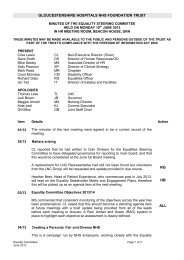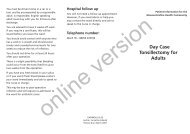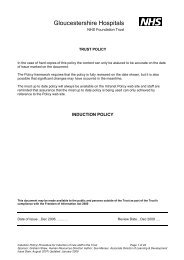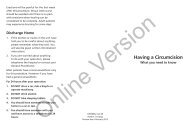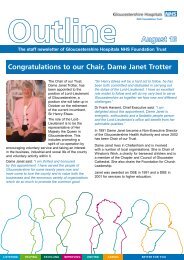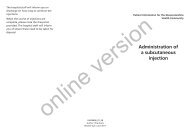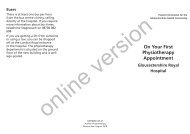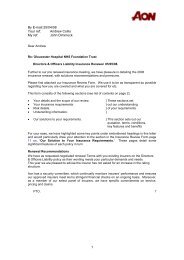Patient Safety Strategy - Gloucestershire Hospitals NHS Trust
Patient Safety Strategy - Gloucestershire Hospitals NHS Trust
Patient Safety Strategy - Gloucestershire Hospitals NHS Trust
You also want an ePaper? Increase the reach of your titles
YUMPU automatically turns print PDFs into web optimized ePapers that Google loves.
GLOUCESTERSHIRE HOSPITALS <strong>NHS</strong> FOUNDATION TRUST<br />
PATIENT SAFETY STRATEGY<br />
ANNEX A<br />
1. <strong>Gloucestershire</strong> <strong>Hospitals</strong> has a key strategic objective – to maximise patient safety.<br />
Promoting safety will save lives and reduce avoidable harm, the challenge for the <strong>Trust</strong><br />
is to get everyone to believe that it will and to support and engage clinical staff in<br />
activities that take this forward and grow a safety culture.<br />
2. <strong>Patient</strong> safety findings across the UK indicate that around 10% of patients experience<br />
an adverse event during an acute admission. The overwhelming majority result in no<br />
harm, however, around 50% are believed to be avoidable. This also indicates that<br />
there are areas of care that are both ineffective and inefficient and lead to<br />
unsatisfactory patient experiences.<br />
3. Across the world in countries such as America, Canada, Japan, Denmark, Australia<br />
and several European countries, direct action to reduce levels of avoidable mortality<br />
has been initiated. Campaigns such as the “Saving lives” campaign have<br />
demonstrated that any hospital can reduce its mortality rates by taking specific action<br />
in key areas.<br />
4. The English campaign “<strong>Safety</strong> First” was launched in 2008 with a focus on reducing<br />
avoidable adverse events through key programmes of improvement. The campaign<br />
builds on initiatives developed by the Institute for Healthcare Improvement (IHI) where<br />
the evidence base has been scrutinised and measurements demonstrating improving<br />
safety have been developed.<br />
5. To meet the <strong>Trust</strong>’s objective, to maximise patient safety, a safety programme will be<br />
established reflecting national and international experience and building on the<br />
progress of the past year and the Leadership in <strong>Patient</strong> <strong>Safety</strong> programme.<br />
6. Providing quality of care and safety will also lead to cost–effective care by<br />
systematically reducing avoidable adverse events which result in extended hospital<br />
stays and readmissions. The <strong>Trust</strong> must strive to be the best at providing quality of<br />
care and safety which is both effective and efficient and provides patients with a<br />
positive experience.<br />
Culture, Values and Performance<br />
7. To provide the right environment for a safety strategy it is important to foster and<br />
support a just culture where staff are treated consistently and fairly at all levels. This<br />
means that the <strong>Trust</strong> Board, managers and clinicians openly support staff and see any<br />
adverse event and near miss, as an opportunity to learn and improve. A healthy<br />
organisation “really” believes that it is better to invest its time and energy in<br />
systematically learning from the 99% of incidents that don’t require any formal<br />
disciplinary action rather than the 1% that might.<br />
8. Consistently across the world, evidence shows that patients who have suffered<br />
adverse events want an apology and reassurance that it won’t happen again. To<br />
achieve this it must be the normal response to engage patients and their relatives in<br />
investigations of all types and provide thoughtful and honest feedback.<br />
9. A safety culture must be supported by visual safety leadership through executive<br />
walkabouts and safety campaign leads, who, will engage front line staff and identify<br />
champions to develop solutions. Individual initiatives will have the support of a<br />
programme lead, and local clinical champions.<br />
10. This process must be supported by good clinical measurement (metrics). These<br />
metrics will be derived from the individual safety programmes and linked with the<br />
performance framework of the <strong>Trust</strong>. The emphasis will be to provide initial<br />
benchmarking, monitoring and assurance of performance throughout the <strong>Trust</strong>. Metrics<br />
will be aligned with the PCT contract and other external monitoring needs. This<br />
<strong>Patient</strong> <strong>Safety</strong> <strong>Strategy</strong> - Annex A Page 1 of 8<br />
Main Board, July 2009
information management process must be supported by effective data collection and<br />
robust organisational information arrangements.<br />
11. To deliver the safety agenda a comprehensive range of coaching and training must be<br />
delivered, underpinned by an inclusive safety management system that is integrated<br />
into the everyday work of all staff.<br />
12. <strong>Patient</strong> involvement will be integrated into the work of all programmes so that<br />
improvement of safety includes the patients interpretation of what is important and<br />
improves the patient journey and experience within the <strong>Trust</strong>.<br />
<strong>Trust</strong> <strong>Safety</strong> Aims<br />
13. The <strong>Trust</strong> will reduce adverse events by developing a comprehensive range of safety<br />
initiatives (see below) visibly supported by the Board, with the right culture, ownership<br />
and safety management systems.<br />
14. The Director of <strong>Safety</strong> will coordinate a safety campaign to engage clinical staff and<br />
patients and to promote good practice and celebrate success.<br />
15. The <strong>Trust</strong> aims will be to:<br />
Reduce the number of patients who suffer avoidable harm<br />
Grow a just safety culture<br />
16. To demonstrate the long term success of the programme the <strong>Trust</strong> will develop the<br />
following high level indicators. The <strong>Trust</strong> will also track the Hospital Standardised<br />
Mortality ratio as a proxy indicator for the reduction of mortality.<br />
17. The Global Trigger Tool for Measuring Adverse Events provides an easy-to-use<br />
method for accurately identifying adverse events and measuring the rate of adverse<br />
events over time. Tracking adverse events over time is a useful way to tell if changes<br />
being made are improving the safety of the care processes. The Trigger Tool<br />
methodology includes a retrospective review of a random sample of patient records<br />
using “triggers” (or clues) to identify possible adverse events.<br />
The success criteria will be a reduction of adverse events by 30% in three years<br />
against the current rate.<br />
18. To improve the ownership and culture of the organisation, the Director of <strong>Safety</strong> will<br />
establish a programme of safety walkabouts with the executive team. Completion of<br />
the walkabout programme and actions taken on the messages and issues received<br />
from the workplace will be reported and monitored through to the Quality Committee.<br />
18.1. The success criteria for this objective will be to complete 85 walkabouts a year<br />
and to complete 70% of the actions agreed.<br />
18.2. To improve the fairness and effectiveness rating for incidents reporting as<br />
measured by the annual staff survey year on year.<br />
Key Responsibility<br />
19. The <strong>Trust</strong> Board should set the direction for effective patient safety systems which<br />
should be an integral part of the organisation’s culture, of its values and performance<br />
standards. All Board members should take the lead in ensuring the communication of<br />
<strong>Safety</strong> programmes and benefits.<br />
20. The Chief Executive is the Accounting Officer for <strong>Gloucestershire</strong> <strong>Hospitals</strong> <strong>NHS</strong><br />
Foundation <strong>Trust</strong>. He is accountable for ensuring that the <strong>Trust</strong> can discharge its legal<br />
duty for all aspects of safety each year, and for the health & safety of staff, visitors and<br />
contractors in the <strong>Trust</strong>.<br />
21. A Non-executive Director must be identified and be assured that patient safety is<br />
being addressed; the NED lead will act as a scrutinizer – ensuring the processes to<br />
support and assure the Board facing significant patient safety risks are robust.<br />
<strong>Patient</strong> <strong>Safety</strong> <strong>Strategy</strong> - Annex A Page 2 of 8<br />
Main Board, July 2009
22. The Medical Director and Director of Nursing, in partnership with the Director of<br />
<strong>Safety</strong> will ensure organisational arrangements are in place for continuous monitoring<br />
and safety improvements for patients.<br />
23. Executive and Divisional Directors are accountable for the safety activities in their<br />
areas of responsibility; their organisational structure must be able to discharge the<br />
requirements of patient safety.<br />
24. The Director of <strong>Safety</strong> has a particular responsibility for leading the <strong>Safety</strong><br />
programmes and risk management for both clinical and non clinical (health and<br />
safety). He manages the risk teams which liaise closely with the Divisional teams to<br />
support their activities. He will support and monitor the safety programmes and ensure<br />
they are functioning and provide reports on the appropriate metrics.<br />
25. All staff and managers are responsible for safety within their immediate environment<br />
and for participating in wider governance, quality & risk management issues within<br />
their department. In addition, all staff should have clear objectives set and documented<br />
as part of their annual performance reviews.<br />
<strong>Safety</strong> Programme<br />
26. The <strong>Trust</strong> is partnering with the SHA and Health Foundation to establish and support a<br />
safety programme. The programme will have five main streams:<br />
Leadership Dr Frank Harsent Chief Executive<br />
General Ward Mrs Maggie Arnold Director of Nursing<br />
Critical care Dr Sally Pearson Director of Planning<br />
Medicines Management Dr Sean Elyan Medical Director<br />
Peri-operative Care. Ms Evelyn Barker Director of Service<br />
Delivery<br />
27. Each stream has an executive lead (see above), and will appoint a systems lead<br />
(champions) and a day-to-day manager. The initiatives will be bench marked (self<br />
assessed) with the support of the SHA and Health Foundation and a safety<br />
programme established. Where possible the initiatives will be aligned with the PCT<br />
requirements. (CQUIN) The metrics from these programmes will form part of the long<br />
term assurance of the <strong>Trust</strong>s safety.<br />
28. The programmes will form the basis of Divisional safety plans for quality and the<br />
Quality accounts, infection control will be embedded within each programme.<br />
29. The successful techniques and processes each year will form part of a database of<br />
safety initiatives, so that in the following year clinical areas can adopt the practice on a<br />
rolling programme of improvement. This information will be fed into the local annual<br />
planning systems that contribute towards the Divisions annual plan.<br />
30. Each initiative will establish a project plan and metrics to monitor and measure<br />
improvements. The programmes will be regularly monitored by the Divisions quality<br />
arrangements and shared with either the <strong>Patient</strong> <strong>Safety</strong> Forum or the Health & <strong>Safety</strong><br />
Committee and assurance will provided to the Quality Committee through the Quality<br />
reports. Key operational concerns will be reported to <strong>Trust</strong> Management Team<br />
meeting and overall performance to <strong>Trust</strong> Board.<br />
Meeting National <strong>Safety</strong> Standards<br />
31. In parallel to the safety programmes, the <strong>Trust</strong> will also aim to meet all relevant<br />
national standards. This will demonstrated by aiming for <strong>NHS</strong>LA level 3 for General<br />
and Maternity Standards over the next 3-5 years. To effectively implement all safety<br />
solutions recommended by the National <strong>Patient</strong> <strong>Safety</strong> Agency and the wider Safer<br />
Alert Bulletins, and each year demonstrably build on the Healthcare Commission<br />
standards relevant to safety.<br />
<strong>Patient</strong> <strong>Safety</strong> <strong>Strategy</strong> - Annex A Page 3 of 8<br />
Main Board, July 2009
Summary<br />
32. The <strong>Trust</strong> will aim to become the best at reducing unnecessary harm to patients with a<br />
comprehensive safety programme led by the Board, with an open and learning culture,<br />
engaging front line staff and patients to develop solutions supported by effective<br />
information management.<br />
Andrew Seaton<br />
May 2009<br />
<strong>Patient</strong> <strong>Safety</strong> <strong>Strategy</strong> - Annex A Page 4 of 8<br />
Main Board, July 2009
Appendix 1<br />
Nationally agreed <strong>Safety</strong> Measures<br />
Critical care<br />
The recommended measures are:<br />
Ventilator bundle compliance<br />
Days between Ventilator associated pneumonias (VAP)<br />
Central Line bundle compliance<br />
Days between central line infections (CLI)<br />
Additional measures are:<br />
VAP rate per 1,000 ventilator days<br />
CLI rate per 1,000 central line days<br />
Ventilator length of stay<br />
Length of stay in ICU<br />
These measures are in use with the 1000 Lives campaign in Wales and also used by the Safer <strong>Patient</strong>s Initiative.<br />
Peri-operative care<br />
The recommended measures are:<br />
SSI rate 30 days post operation<br />
SSI bundle compliance<br />
% antibiotics administered on time<br />
% antibiotics discontinued on time<br />
% surgery with appropriate hair removal<br />
% of surgical patients with perioperative normothermia<br />
% diabetics with controlled glucose<br />
% patients with appropriate hair removal<br />
% compliance with use of the WHO Surgical <strong>Safety</strong> Checklist<br />
Some of these measures are in use with the 1000 Lives campaign in Wales and also used by the Safer <strong>Patient</strong>s Initiative.<br />
Deterioration<br />
The recommended measures are:<br />
<strong>Patient</strong> <strong>Safety</strong> <strong>Strategy</strong> - Annex A Page 5 of 8<br />
Main Board, July 2009
The number of cardiac arrests per month<br />
The number of Rapid Response calls per month<br />
The percentage of Rapid Response team communications performed with your chosen communication tool. We have created measures<br />
for SBAR and RSVP, simply select the one you are using. If you use another tool, you will need to create a custom measure. Please<br />
contact the campaign team for further guidance on how to do this.<br />
If you want more information on where your process for dealing with deteriorating patients is working or not working, you might like to<br />
consider the following process measures:<br />
The percentage of patient observations complete<br />
The percentage of patients who triggered that had an appropriate reaction<br />
These can both be picked up while doing the GTT audit. We also strongly recommend performing a mortality case note review to get a<br />
handle on the issues surrounding unexpected death.<br />
High risk medicines<br />
The campaign is focusing on 4 drugs or drug groups: Anticoagulants, Opiates, Insulin and anaesthetic sedatives. Ideally we would want to<br />
measure compliance with treatment protocol (a process measure) and adverse drug events related to these drugs (an outcome measure).<br />
However these are extremely labour intensive to collect and so we recommend a series of proxy outcome measures as follows because<br />
they are more straightforward to collect:<br />
% of inpatient warfarin doses administered according to protocol *<br />
Number of patients receiving Warfarin with INR >6<br />
Number of patients receiving Warfarin with INR >5 *<br />
Number of patients receiving Warfarin with INR >8 *<br />
% of patients receiving low molecular weight heparin outside protocol limits *<br />
Number of patients receiving flumazenil to counteract effects of midazolam *<br />
% of patients with no INR recorded on inpatient warfarin prescription *<br />
Additional measures<br />
There are additional measures contained in the How To Guide that participants may want to use to assess compliance with protocols and<br />
measure real outcomes. They are:<br />
The number of patients who received opiates who receive subsequent treatment with naloxone *<br />
Number of patients who received 25%/ 50% glucose to correct insulin induced hypoglycaemia<br />
Reported anticoagulant adverse event rate *<br />
Adverse event rate associated with use of low molecular weight heparin and unfractionated heparin<br />
Injectable sedative adverse event rate *<br />
<strong>Patient</strong> <strong>Safety</strong> <strong>Strategy</strong> - Annex A Page 6 of 8<br />
Main Board, July 2009
% of patients treated within opiate protocol *<br />
Opiate adverse event rate *<br />
Insulin adverse event rate *<br />
* These measures are in use with the 1000 Lives campaign in Wales.<br />
There are 4 other interventions VTE, falls, surviving sepsis bundle, and peripheral lines that are under development.<br />
<strong>Patient</strong> <strong>Safety</strong> <strong>Strategy</strong> - Annex A Page 7 of 8<br />
Main Board, July 2009
Appendix 2<br />
Ward\Department<br />
Involved<br />
<strong>Safety</strong><br />
Project<br />
<strong>Safety</strong><br />
Theme<br />
i.e. Wards<br />
Clinical<br />
Champion<br />
Target<br />
Metric(s)<br />
<strong>Patient</strong> <strong>Safety</strong> <strong>Strategy</strong> - Annex A Page 8 of 8<br />
Main Board, July 2009



